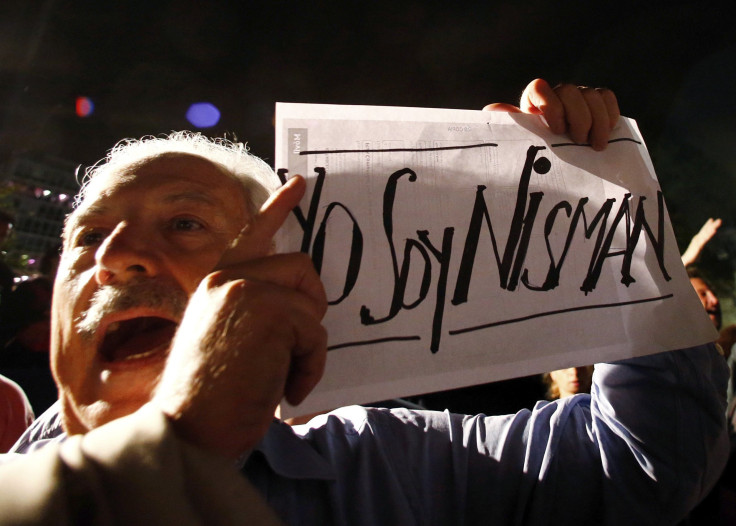Argentina Court Publishes Late Prosecutor's Full Accusations Against President Kirchner

Suspicions are still abounding in Argentina over the shocking death of federal prosecutor Alberto Nisman, who was found shot in the head in his home this week just hours before he was due to present evidence behind blistering accusations against President Cristina Fernandez de Kirchner. Those accusations are now public in the form of a nearly 300-page tome, and Argentines are scouring the pages to detect any hints of a link between the document and his tragic demise.
Nisman had spent the past decade investigating the 1994 bombing of a Jewish community center in Buenos Aires, Argentina’s worst terrorist attack in history -- and the greatest murder of Jewish civilians anywhere since World War II -- that resulted in 85 deaths and 300 injuries. No one was ever convicted of the crime. The prosecutor, who said he collected a wealth of information through wiretaps of secret conversations, was preparing to present a judge with a 298-page denunciation of several Argentine officials who he said helped cover up Iran’s involvement in the bombing.
Nisman had indicted eight people for the attacks in 2006, including a member of the Lebanese, Iranian-allied group Hezbollah, high-level Iran government officials and former members of Iran’s Revolutionary Guard; Iran denied any connection and refused to turn over any of the accused individuals. Kirchner signed an agreement with Iran in 2013 to establish a joint “truth commission” on the bombing – a decision that alarmed many, including Nisman, who saw it as cooperation with the perpetrators of the attack.
The court released the full text of the document late Tuesday as Argentines took to the streets to demand answers for Nisman's death. Here are some of the key points:
At the center of Nisman’s accusations is the 2013 Memorandum of Understanding between Argentina and Iran, which he argued was secretly aimed at guaranteeing impunity for the Iranians implicated in the attack and taking their names off Interpol’s wanted list. In exchange, he wrote, Argentina would receive needed oil from Iran and export grains and meat to Tehran.
While Nisman said Kirchner directed the memorandum, he named several others – including Foreign Minister Hector Marcos Timerman, political deputy Andres Larroque and leftist activists Luis d’Elia and Fernando Esteche – as accomplices in the alleged cover-up. Timerman, who is Jewish himself, was the principal figure in charge of executing the plan, Nisman wrote.
- According to the document, the findings drew from wiretaps of Argentine officials’ conversations with several Iranian figures, including Iranian businessman Jorge Alejandro Khalil, cited as the “central link” between Iranian and Argentine officials, and Mohsen Rabbani, former cultural attaché at the Iranian Embassy in Buenos Aires and one of the Iranians indicted for the 1994 attack. Nisman included transcriptions of phone conversations between these officials that allegedly reference the secret accord.
- Nisman also implicates a mysterious agent known as “Allan,” an alleged spy with close connections to the president’s inner circle who Nisman said handled sensitive information about the deal at Kirchner’s request.
- Nisman takes direct aim at President Kirchner, calling her an “actress” before the families of the bombing victims. “A president that has publicly reveled in showing her commitment to the search for truth to the survivors and families of the victims, who has declared that her government would not permit using the case in a geopolitical chess game, who has taken on the matter because the cause was paralyzed, was in fact the principal architect, along with Chancellor Timerman, of the fraudulent dismantling of the investigation and cover-up of these accusations,” he wrote. “In speeches, she spoke of justice and truth. In her deeds, she granted impunity.”
Argentine government officials have vehemently denied the charges. “There is absolutely nothing there,” said Anibal Fernández, secretary general of the presidency, calling the charges “flimsy” while speaking to local reporters Wednesday. Kirchner, meanwhile, had already responded to the accusations via her Facebook page Monday, before the full document was released to the public. “I believe the most important thing is to warn is that he was trying to do with the case is the same thing that was done with the case 21 years ago: sidetrack, lie, cover up and confuse,” her post wrote.
The government has maintained the theory that Nisman’s death was a suicide, as he was found in his locked apartment with no signs of forced entry, a .22-caliber gun and shell casing at his side. But critics have been wary of that conclusion, pointing out there was no suicide note or gunpowder detected in his hand, and that he had been frequently threatened over his work. An investigation into his death is in progress.
© Copyright IBTimes 2025. All rights reserved.






















